Dennis Stacy
s Alaska continues to grapple with a housing shortage, multi-family property loans are crucial to prospective investors and individuals seeking a path to affordable homeownership.
The multi-family lending environment has remained much the same for properties with five or more units, according to Eric Hamilton, a commercial real estate loan officer with Northrim Bank. But there have been some changes related to financing for one- to four-unit residential properties, including more relaxed down payment requirements with some federal programs.

Northrim Bank

Nuvision Credit Union
Adopted under the Housing Opportunities in the Municipality for Everyone (HOME) initiative, the city’s new ordinance allows detached, single-family units on the same lot to count as one duplex in code. According to Assembly Member Daniel Volland, the HOME initiative is about creating conditions in Anchorage that are favorable to new housing while expanding the potential for owner-builders and owner-occupants.
It’s wonderful that the Anchorage Assembly approved duplexes to be built in areas previously zoned for single-family homes, Karcz says. But the high cost of construction in Anchorage has a significant effect on the availability of multi-family financing. For instance, if a borrower has to complete certain repairs, it will impact their reserves and make it more difficult to qualify for Fannie Mae’s 5 percent down opportunity to become first-time homeowners and real estate investors. “Owner-occupied properties are typically a stepping-stone for people; they want to live there, save money, and be able to move up and buy something different,” she says.
Most multi-family residential lending is financed through government-backed loan programs like the Federal Housing Administration, US Department of Housing and Urban Development, Fannie Mae, and Federal Home Loan Mortgage Corporation. These can be used for either strictly investment (with 20 percent to 25 percent down) or an owner-occupied financing structure (with less down payment). On the commercial side, a significant source of funding in Alaska is the Alaska Housing Finance Corporation (AHFC) multi-family lending program. “This program does not put restrictions on the age of the property and allows for up to 80 percent financing and a longer, fully amortizing, fixed-rate loan structure,” Hamilton says. “Commercial lending banks/credit unions in Alaska, for similar financing, typically do not offer these terms.”
Although AHFC is the dominant player in the state for multi-family lending for five-plus-unit properties, if an investor is building a new multi-family structure or has recently upgraded the property with significant capital improvements, a bank or credit union may be willing to look at financing those projects in-house. An in-house loan—which financial institutions tend to do on a limited basis—can offer a number of advantages. Hamilton explains, “The benefit to this is a quicker closing; some restrictions that other government programs apply in other lending programs may not be included; up-front loan fees may be lower; and the ability to get creative or think outside the box may be beneficial to the investor/borrower.”
In September 2024, Northrim provided a $3.7 million loan that enabled Walter Weston to purchase a new twenty-four-unit property in Eagle River. Reflecting on the transaction, Weston says, “Eric Hamilton and his team at Northrim Bank were fantastic to work with—responsive to our needs and highly knowledgeable.”
Nuvision offers both residential and commercial loan options to help individuals purchase multi-family properties, whether through Federal Housing Administration, Housing and Urban Development, or US Department of Veterans Affairs loans. These loan programs can also be combined with AHFC programs or standard Fannie Mae loans, depending on the borrower’s eligibility.
Nuvision typically notifies borrowers ahead of time if their situation warrants the credit union keeping their loan in-house (as part of its loan portfolio). Perhaps the borrower is going to reduce rent to allow new renters to come in to increase cash flow, or maybe the property is completely vacant due to renovations. “If you’re understanding what the cash flow is doing—and perhaps you’re not quite there on the debt service—we can possibly use underwriting guidelines in place to keep the loan in our loan portfolio to allow flexibility within the financing,” Karcz says.
A multi-family commercial loan can be ideal for borrowers who want to deviate from the black-and-white standards of government-backed funding. That’s the route Dennis Stacy took with financing four duplexes through Nuvision. All four loans—ranging from $256,900 to $300,000—were thirty-year conventional mortgages with fifteen-year balloon payments. The investment properties, centrally located in the E.M. Jones subdivision in Fairbanks—have been fully rented since the loans closed in August, September, and October 2021.
“My experience working with Emily Pippin and the other people in the mortgage department at Nuvision was nothing but positive,” Stacy recalls. “Emily always addressed any of my concerns or questions in a positive and professional manner and did her best to expedite my loans in a timely manner. I’m very happy with the service I received. As a matter of fact, when my wife and I completed building our dream home in 2023 and we needed a mortgage, I immediately contacted Emily to help us with it.”

First National Bank Alaska
Contrasting these two options, Scott says, “AHFC is a good product if you fit within their criteria and strict guidelines that require checking every box. With our portfolio loans, the financing decision stays within the bank, where we are the final approver, so we are able to tailor financing solutions to the borrower’s specific situation.”
For instance, with a commercial multi-family portfolio loan, the bank can make loan-specific decisions related to property inspections, repairs, and escrow for property taxes, insurance, or replacement reserves. This can be beneficial for a borrower who has a property being rented under market value but has plans for increasing rents. Additionally, First National can customize the terms of the loan based on the borrower’s plans for significant property improvements within the first six months. “It may be possible to structure the loan with a six-month, interest-only payment period and then transition to fully amortized payments after that,” Scott says. “At First National, we have more flexibility to be creative and structure the loan to fit the borrower’s specific needs.”
Nuvision, for example, evaluates the creditworthiness of borrowers by assessing their ability to repay the loan. This can entail reviewing tax returns for the last two years, the appraiser’s fair market rent survey (or lease agreement, if applicable), as well as W-2 forms and pay stubs for the last two years. In addition, Nuvision considers borrowers’ credit report and FICO score to ascertain a complete picture of their financial stability.
While lending for owner-occupied, multi-family properties is primarily centered on the borrower’s financial profile, loans for non-owner-occupied multi-family properties focus more on the property’s ability to generate income. The property—not the borrower—is considered the primary source of repayment. That’s why lease agreements are essential for demonstrating how the property has performed. “We have to get a complete picture of the financial stability when we look at multi-family—not just of the borrower but of the property as well,” Karcz says.
First National prioritizes the primary source of loan repayment while also analyzing standard financial statements to confirm the borrower’s personal financial strength. The bank must ensure that it can underwrite the loan based on the property’s actual historical cash flow data and the appraisal, which can be based on sales comparisons, cost approach, and income approach. The income approach generally carries the most weight.
Scott says a common misconception among borrowers seeking a multi-family commercial loan is thinking the approval process is based solely on the property’s income. However, beyond that, the bank must ensure that the property is self-sustaining, meaning it generates enough income to exceed the cost of ownership. “It’s almost like we’re evaluating a small business,” he says. “We’re looking for more than one source of payment—a primary, secondary, and even a tertiary source.”
For the primary source of repayment, the bank also needs to substantiate that the net operating income—what remains after deducting utilities, maintenance, and other expenses from rent—can cover 1.25 to 1.45 times the loan’s principal and interest. Additional repayment sources may include other income streams or reserves held in savings or investment accounts.
Borrowers utilizing AHFC’s multi-family loan program may be required to provide even more financial documentation, such as a Schedule E tax form instead of a self-generated profit and loss statement. “In the past few years, AHFC has placed greater emphasis on reviewing not just the appraisal and the potential market income for the property but also historical information,” Scott says.
This process could include verifying the actual occupancy and vacancy reported for the past couple of years, along with utility expenses, instead of just projections based on the appraisal. Scott emphasizes, “We need to ensure there is verifiable financial history to support the loan.”

Northrim Bank
Lendability on a property is commonly analyzed based on five elements: loan-to-value, health and safety, guarantor support, environmental due diligence, and property cash flow/debt service coverage, Tibbs says. And given that four out of the five common underwriting components are property specific, a loan approval is not transferable to a different property. “If you are in the market for a multi-family property, you will have to go through this same process for every property,” he says. “This also makes it virtually impossible to get a ‘pre-approval’ for multi-family commercial.”
Tibbs says most multi-family investors are looking for the maximum loan amount—or the smallest down payment. But there are some major risks with this thought process because borrowers are making a thirty-year decision based on current circumstances. Some theoretical issues that could come up over the course of a thirty-year loan include increasing utility costs, neighborhood deterioration that could drive down rental rates, higher than expected maintenance costs, increasing property management fees, and increasing property taxes. “All of these things can reduce net operating income, but you still have a fixed loan payment,” he says. “A lower loan amount will give you a buffer to weather different financial storms that could come up over three decades.”
Establishing a savings account for maintenance will also help. Tibbs says, “Saving 5 to 10 percent of gross rents each month is a lot easier than coming up with a lump sum for major repairs like a boiler replacement or new roof.”